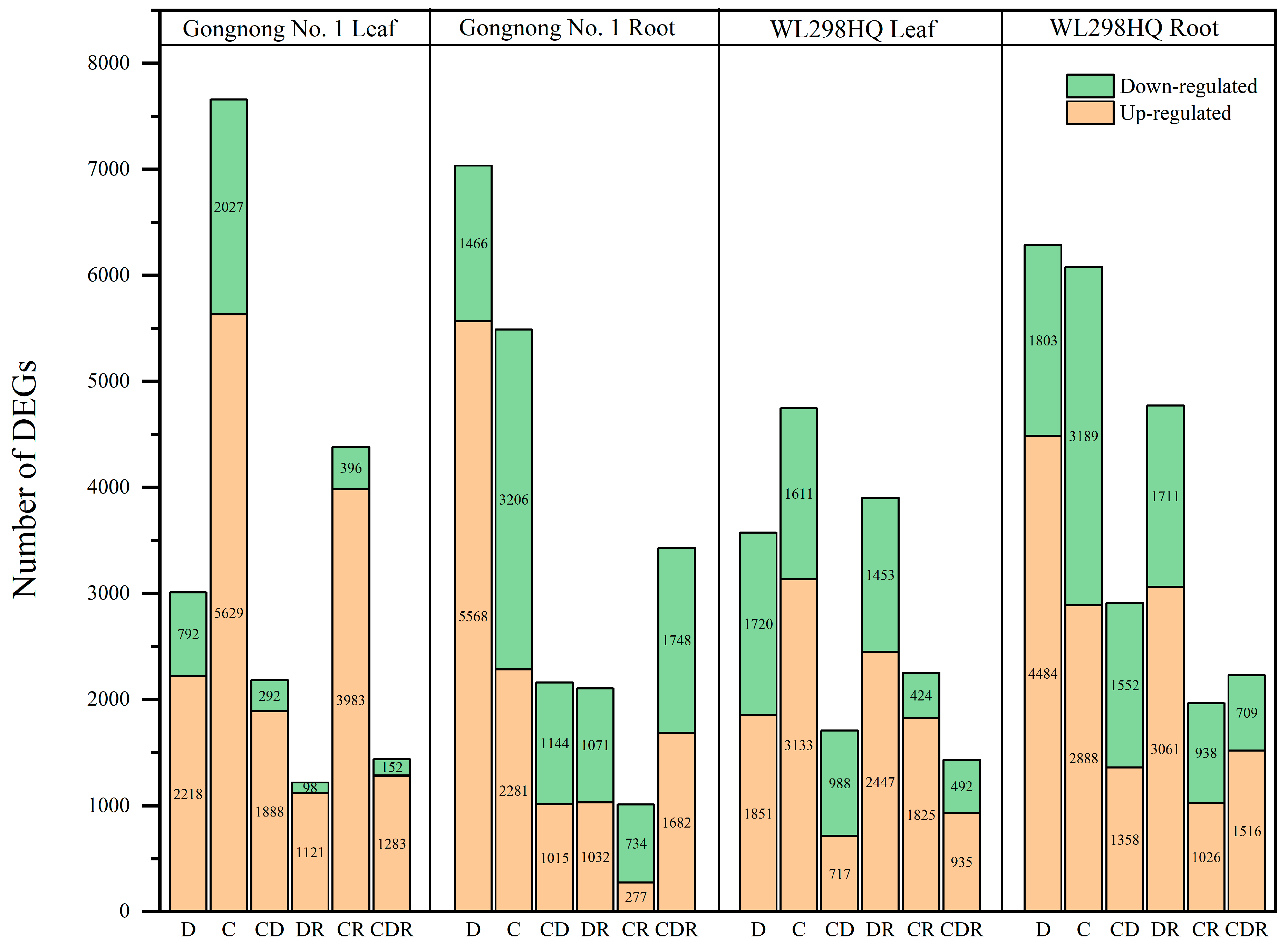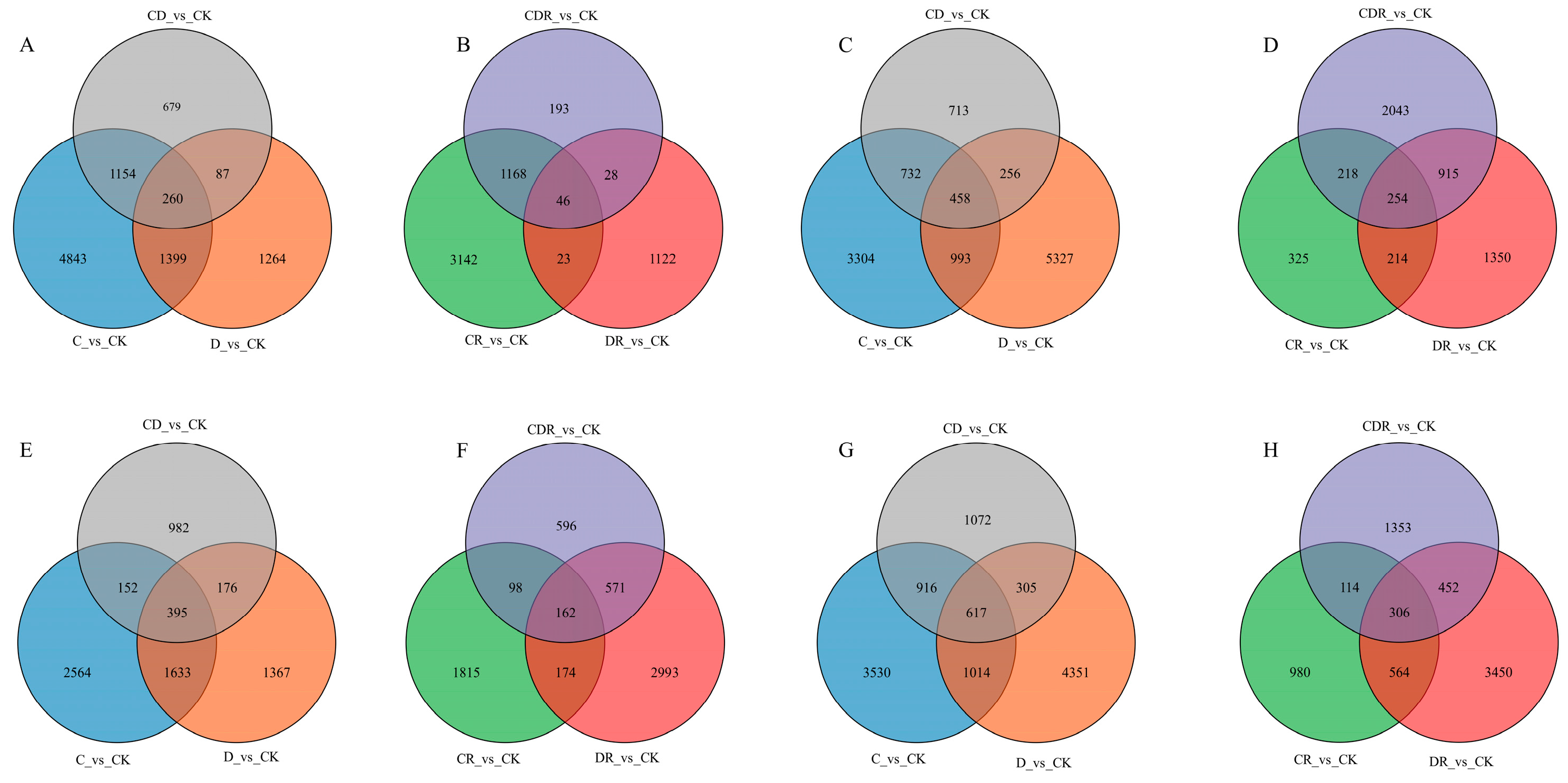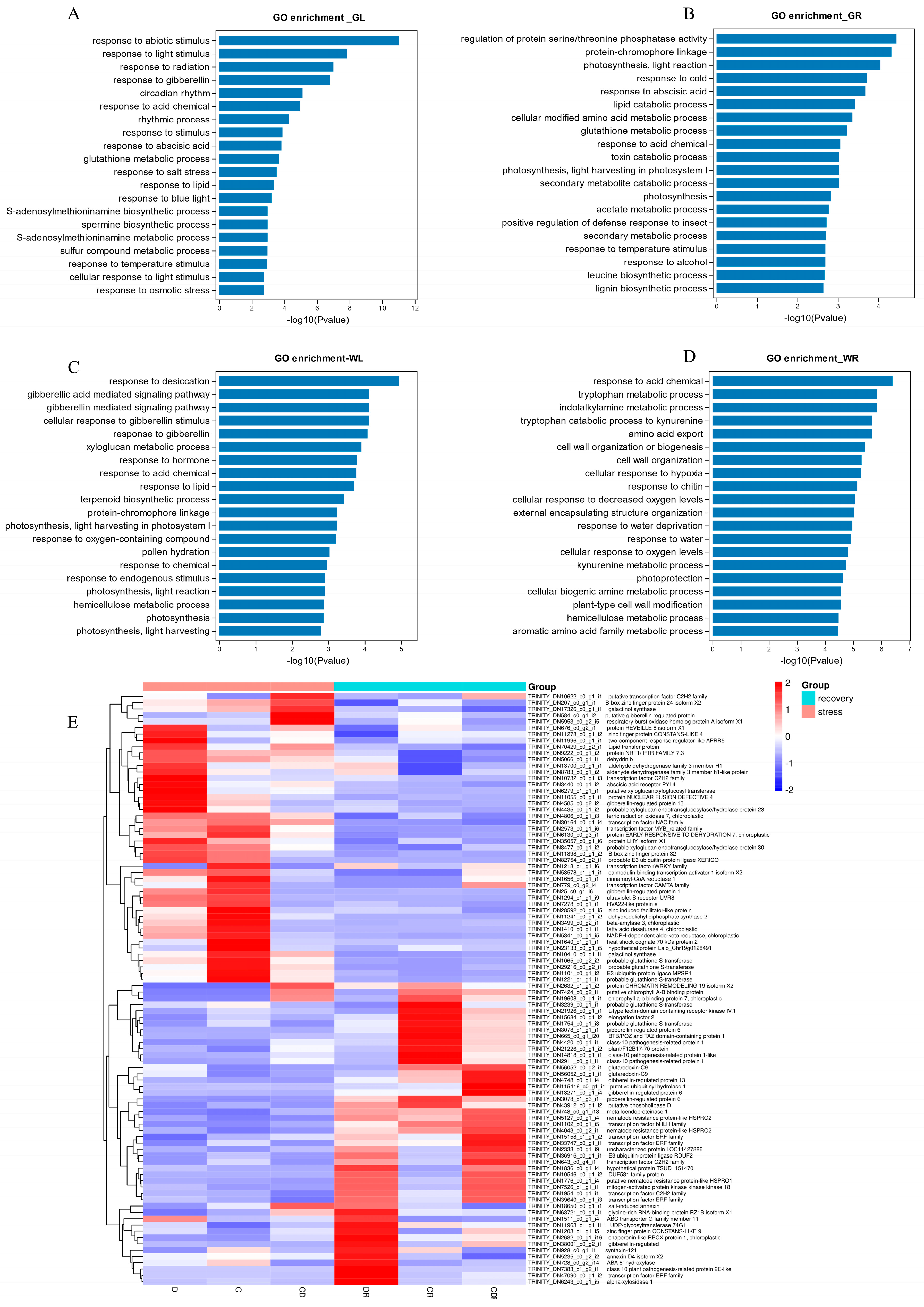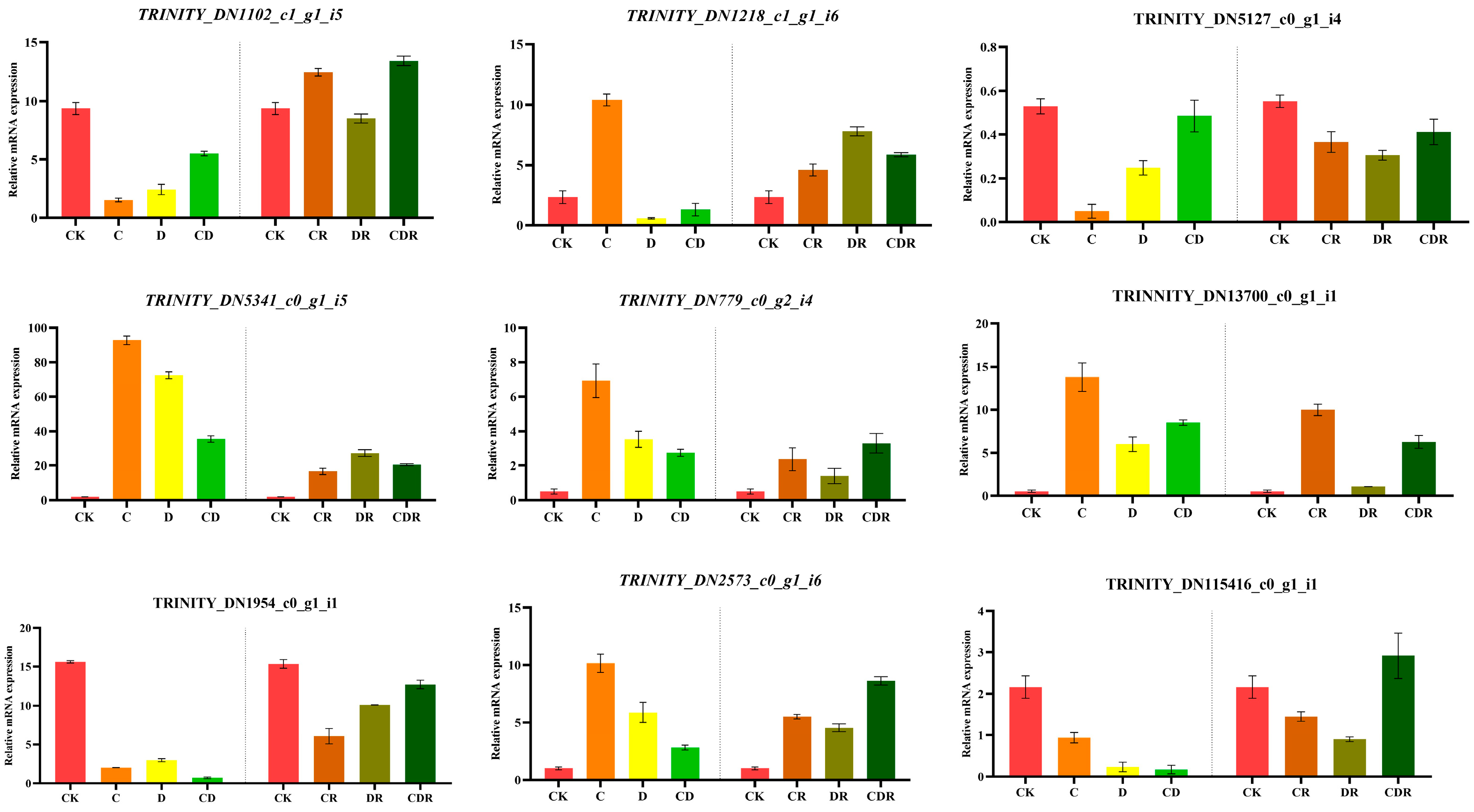Molecular Mechanisms of Alfalfa (Medicago sativa L.) in Response to Combined Drought and Cold Stresses
Abstract
:1. Introduction
2. Materials and Methods
2.1. Experimental Materials
2.2. Alfalfa Seedling Cultivation
2.3. Abiotic Stress Treatments for Alfalfa
2.4. Measurement of Physiological and Biochemical Indicators in Alfalfa
2.5. RNA Sequencing (RNA-Seq)
2.6. RT-PCR Analysis
2.7. Data Analysis
3. Results
3.1. Effects of Drought, Cold, and Combined Stress on Alfalfa Leaf Chlorophyll and Malondialdehyde (MDA) Content
3.2. Effects of Soil Drought, Cold, and Combined Stress on Alfalfa Osmotic Regulation Factors
3.3. Effects of Drought, Cold, and Combined Stress on Alfalfa Leaf Antioxidant Enzyme Content
3.4. Comprehensive Assessment of Different Alfalfa Varieties under Drought, Cold, and Combined Stress
3.5. Sequencing the Transcriptome of Alfalfa under Drought, Cold, and Combined Stresses
3.6. Identification of Differentially Expressed Genes under Drought, Cold, and Combined Stresses
3.7. Functional Classification and Expression of Differentially Expressed Genes
3.8. Validation through Quantitative Real-Time PCR (qRT-PCR)
4. Discussion
5. Conclusions
Supplementary Materials
Author Contributions
Funding
Data Availability Statement
Conflicts of Interest
References
- Li, Y.; Liu, G.; Gao, H.; Wang, Z.; Zhao, H.; Xie, N.; Wang, Y. Study on Comprehensive Evaluation of Drought Resistance of Medicago sativa L. Germplasm at Seedling Stage. Acta Agrestia Sin. 2009, 1, 807–812. [Google Scholar]
- Zhang, M.; Sun, S.; Sun, J.; Chen, J.; Yan, H. Molecular Mechanism of Abiotic Stress Response in Medicago sativa. Mol. Plant Breed. 2023, 21, 2642–2654. [Google Scholar]
- Zhang, J.Y.; Cruz, D.E.; Carvalho, M.H.; Torres-Jerez, I.; Kang, Y.; Allen, S.N.; Huhman, D.V.; Tang, Y.; Murray, J.; Sumner, L.W.; et al. Global Reprogramming of Transcription and Metabolism in Medicago truncatula during Progressive Drought and after Rewatering. Plant Cell Environ. 2014, 37, 2553–2576. [Google Scholar] [CrossRef] [PubMed]
- Li, Q.; Jiang, W.; Wang, Y.; Zhang, B.; Pang, Y. Research Progresses on the Drought Resistance of Medicago at Molecular Level. Biotechnol. Bull. 2021, 37, 243–252. [Google Scholar]
- Wang, Y.; Zhao, M.; Zhang, H.; Lu, Z.; Mu, C. Effects of Drought Stress on Morphological and Physiological Characteristics of Alfalfa Seedlings. Chin. J. Grassl. 2021, 43, 78–87. [Google Scholar]
- Zang, Z.F.; Bai, J.; Liu, C.; Zan, K.Z.; Long, M.X.; He, S.B. Variety Specificity of Alfalfa Morphological and Physiological Characteristics in Response to Drought Stress. Acta Pratacult. Sin. 2021, 30, 73–81. [Google Scholar]
- Feng, K.; Hou, X.L.; Xing, G.M.; Liu, J.X.; Duan, A.Q.; Xu, Z.S.; Li, M.Y.; Zhuang, J.; Xiong, A.S. Advances in AP2/ERF super-family transcription factors in plant. Crit. Rev. Biotechnol. 2020, 40, 750–776. [Google Scholar] [CrossRef] [PubMed]
- Iqbal, Z.; Memon, A.G.; Ahmad, A.; Iqbal, M.S. Calcium Mediated Cold Acclimation in Plants: Underlying Signaling and Molecular Mechanisms. Front. Plant Sci. 2022, 13, 855559. [Google Scholar] [CrossRef]
- He, F.; Zhang, L.; Zhao, G.; Kang, J.; Long, R.; Li, M.; Yang, Q.; Chen, L. Genome-Wide Identification and Expression Analysis of the NAC Gene Family in Alfalfa Revealed Its Potential Roles in Response to Multiple Abiotic Stresses. Int. J. Mol. Sci. 2022, 23, 10015. [Google Scholar] [CrossRef]
- Li, T.; Sun, J.; Liu, J. Role of Different Transcription Factor Families in the Regulatory Networks of Drought and Salinity Tolerance in Plants. Chin. Bull. Life Sci. 2015, 27, 217–227. [Google Scholar]
- Shen, Y.; Xu, Z.; Tang, X.; Yang, X.; Huang, W.; Wu, X.; Zhang, W. Cloning and Function Analysis of the MsNAC2 Gene with NAC Transcription Factor from Alfalfa. Sci. Agric. Sin. 2015, 48, 2925–2938. [Google Scholar]
- Song, Y.; Lv, J.; Qiu, N.; Bai, Y.; Yang, N.; Dong, W. The constitutive expression of alfalfa MsMYB2L enhances salinity and drought tolerance of Arabidopsis thaliana. Plant Physiol. Biochem. 2019, 141, 300–305. [Google Scholar] [CrossRef] [PubMed]
- Liu, Y. Discovery of R2R3-MYB Transcription Factors in Tribulus Terrestris Alfalfa and Their Response to Abiotic Stress. Master’s Thesis, Harbin Normal University, Harbin, China, May 2017. [Google Scholar]
- Wang, T.; Chen, L.; Zhao, M.; Tian, Q.; Zhang, W.H. Identification of drought-responsive microRNAs in Medicago truncatula by genome-wide high-throughput sequencing. BMC Genom. 2011, 12, 367. [Google Scholar] [CrossRef] [PubMed]
- Qian, L.; Jiang, W.; Jiang, Z.; Du, W.; Song, J.; Qiang, Z.; Zhang, B.; Pang, Y.; Wang, Y. Transcriptome and functional analyses reveal ERF053 from Medicago falcata as key regulator in drought resistances. Front. Plant Sci. 2022, 13, 995754. [Google Scholar]
- Yitong, M. Identification and Functional Analysis of Alfalfa-Specific Gene MsASG166 in Response to Drought Stress. Master’s Thesis, Lanzhou University, Lanzhou, China, May 2022. [Google Scholar]
- Fu, J. Mechanism of Low Temperature Adaptation of Wild Pitcher Plant in Tibet. Ph.D. Thesis, Northwest Agriculture and Forestry University, Xianyang, China, March 2017. [Google Scholar]
- Liu, H.; Li, D.; Deng, Z. Advances in Research of Transcriptional Regulatory Network in Response to Cold Stress in Plants. Sci. Agric. Sin. 2014, 47, 3523–3533. [Google Scholar]
- Fang, M.; Wang, Y.; Zhao, Y. Morphological and Physiological Responses of Eight Alfalfa Cultivars to Combined Stress of Cold and Drought. J. Grassl. Sci. 2022, 30, 2967–2974. [Google Scholar]
- Han, R.; Lu, X.; Gao, G.; Yang, X. Analysis of the Principal Components and the Subordinate Function of Alfalfa Drought Resistance. J. Acta Agrestia Sin. 2006, 2, 142–146. [Google Scholar]
- Zhang, D.; Sun, Y.; Zhao, L.; Chou, M. Reference Gene Selection for Quantitative Real-time PCR Normalization in Medicago Lupulina Under Zinc Stress. Screening of real-time quantitative PCR internal reference genes under zinc stress in sky blue alfalfa. China Environ. Sci. 2015, 3, 833–838. [Google Scholar]
- Livak, K.J.; Schmittgen, T.D. Analysis of Relative Gene Expression Data Using Real-Time Quantitative PCR and the 2−ΔΔCT Method. Methods 2001, 25, 402–408. [Google Scholar] [CrossRef]
- Zhang, H.; Zhu, J.; Gong, Z.; Zhu, J. Abiotic stress responses in plants. Nat. Rev. Genet. 2022, 23, 104–119. [Google Scholar] [CrossRef]
- Deng, X.; Qiao, D.; Li, L.; Zhang, N.; Lei, G.; Cao, Y. The Effects of Chilling Stress on Physiological Characters of Medicago Sativa. J. Sichuan Univ. 2005, 01, 190–194. [Google Scholar]
- Han, R.; Lu, X.; Gao, G.; Yang, X. Photosynthetic physiological response of alfalfa (Medicago sativa) to drought stress. J. Acta Ecol. Sinca. 2007, 12, 5229–5237. [Google Scholar]
- Chen, L.; Wang, J.; Qiu, X.; Sun, H.; Zhang, W.; Wang, T. Differences of Physiological Responses and Transcriptional Regulation of Alfalfa with Different Drought Tolerances Under Drought Stresses. Acta Agron. Sin. 2023, 49, 2122–2132. [Google Scholar]
- Li, X.; Topbjerg, H.B.; Jiang, D.; Liu, F. Drought priming at vegetative stage improves the antioxidant capacity and photosynthesis performance of wheat exposed to a short-term low temperature stress at jointing stage. Plant Soil 2015, 393, 307–318. [Google Scholar] [CrossRef]
- Liu, Y.; Geng, J.; Song, J.; Sha, X.; Hu, T.; Yang, P. Effect of Root Nodules on Cold Resistance of Alfalfa (Medicago sativa). J. Acta Agrestia Sin. 2018, 26, 631–638. [Google Scholar]
- Liu, J.; Wu, J.; Laduo; Luo, L.; Wang, Y. Effects of Combined Cold and Drought Stress on the Physiological and Biochemical Characteristics of Triticale wittmack. Tibet J. Agric. Sci. 2022, 44, 53–61. [Google Scholar]
- Wei, J.; Xu, C.; Li, K.; He, H.; Xu, Q. Progress on Superoxide Dismutase and Plant Stress Resistance. J. Plant Physiol. J. 2020, 56, 2571–2584. [Google Scholar]
- Yang, M.; Duan, X.; Wang, Z.; Yin, H.; Zang, J.; Zhu, K.; Wang, Y.; Zhang, P. Overexpression of a Voltage-Dependent Anion-Selective Channel (VDAC) Protein-Encoding Gene MsVDAC from Medicago sativa Confers Cold and Drought Tolerance to Transgenic Tobacco. Genes 2021, 12, 1706. [Google Scholar] [CrossRef]
- Ma, Y.; Yang, G.; Tong, Y.; Liu, Z. Effects of Low Temperature Stress on the Physiological Characteristics of Medicago sativa Seedlings. J. Qinghai Univ. 2022, 40, 16–19. [Google Scholar]
- Sun, Y.; Li, J.; Sun, B.; Wang, G.; ShenN, X.; Ran, N.Z. Responses of Cold Resistance Physiological Indices of Different Alfalfa Varieties to Cold Stress. J. Shenyang Agric. Univ. 2017, 48, 591–596. [Google Scholar]
- Han, Z.; Zheng, M.; Liang, X.; Kang, J.; Chen, Y. Effects of Drought Stress on Morphological and Physiological Characteristics of Different Alfalfa Cultivars. Chin. J. Grassl. 2020, 42, 37–43. [Google Scholar]
- Zhou, Q.; Luo, D.; Chai, X.; Wu, Y.; Wang, Y.; Nan, Z.; Yang, Q.; Liu, W.; Liu, Z. Multiple Regulatory Networks Are Activated during Cold Stress in Medicago sativa L. Int. J. Mol. Sci. 2018, 19, 3169. [Google Scholar] [CrossRef]







| Stress Treatments | Sample | Membership Function Values | Total D Value | ||||||
|---|---|---|---|---|---|---|---|---|---|
| CHL | MDA | SOD | CAT | POD | Pro | SP | |||
| Drought | WL298HQ | 1.00000 | 0.97994 | 1.00000 | 1.00000 | 1.00000 | 0.79837 | 1.00000 | 6.77831 |
| Gongnong No. 1 | 1.00000 | 1.00000 | 0.75754 | 0.60137 | 1.00000 | 0.77787 | 1.00000 | 6.13678 | |
| Cold | WL298HQ | 0.73462 | 0.55795 | 0.66391 | 0.95635 | 0.90623 | 0.65385 | 0.86313 | 5.33604 |
| Gongnong No. 1 | 0.55192 | 0.92599 | 0.99186 | 0.81802 | 0.76199 | 0.64111 | 0.67355 | 5.36444 | |
| Combined (Drought & Cold) | WL298HQ | 0.30605 | 1.00000 | 0.83792 | 0.89831 | 0.65568 | 1.00000 | 0.50502 | 5.20298 |
| Gongnong No. 1 | 0.54177 | 1.06924 | 1.00000 | 1.00000 | 0.65682 | 1.00000 | 0.71276 | 5.98059 | |
| Overall Comprehensive | WL298HQ | 2.04067 | 2.53789 | 2.50183 | 2.85466 | 2.56191 | 2.45221 | 2.36815 | 17.31733 |
| Ginning No. 1 | 2.09370 | 2.99523 | 2.74940 | 2.41939 | 2.41881 | 2.41898 | 2.38631 | 17.48181 | |
| Parameter | Data |
|---|---|
| Total Raw Reads | 3,731,603,228 |
| Total Clean Reads | 3,469,831,420 |
| Total Sequence Count | 260,664 |
| Total Sequence Bases | 292,266,467 |
| GC Percentage | 40% |
| Longest Transcript Length | 15,793 |
| Shortest Transcript Length | 501 |
| Average Transcript Length | 1121 |
| N50 Value | 1291 |
Disclaimer/Publisher’s Note: The statements, opinions and data contained in all publications are solely those of the individual author(s) and contributor(s) and not of MDPI and/or the editor(s). MDPI and/or the editor(s) disclaim responsibility for any injury to people or property resulting from any ideas, methods, instructions or products referred to in the content. |
© 2023 by the authors. Licensee MDPI, Basel, Switzerland. This article is an open access article distributed under the terms and conditions of the Creative Commons Attribution (CC BY) license (https://creativecommons.org/licenses/by/4.0/).
Share and Cite
Aili, R.; Deng, Y.; Yang, R.; Zhang, X.; Huang, Y.; Li, H.; Jia, S.; Yu, L.; Zhang, T. Molecular Mechanisms of Alfalfa (Medicago sativa L.) in Response to Combined Drought and Cold Stresses. Agronomy 2023, 13, 3002. https://doi.org/10.3390/agronomy13123002
Aili R, Deng Y, Yang R, Zhang X, Huang Y, Li H, Jia S, Yu L, Zhang T. Molecular Mechanisms of Alfalfa (Medicago sativa L.) in Response to Combined Drought and Cold Stresses. Agronomy. 2023; 13(12):3002. https://doi.org/10.3390/agronomy13123002
Chicago/Turabian StyleAili, Reziya, Yantian Deng, Rui Yang, Xiaopeng Zhang, You Huang, Heyang Li, Shangang Jia, Longxi Yu, and Tiejun Zhang. 2023. "Molecular Mechanisms of Alfalfa (Medicago sativa L.) in Response to Combined Drought and Cold Stresses" Agronomy 13, no. 12: 3002. https://doi.org/10.3390/agronomy13123002





